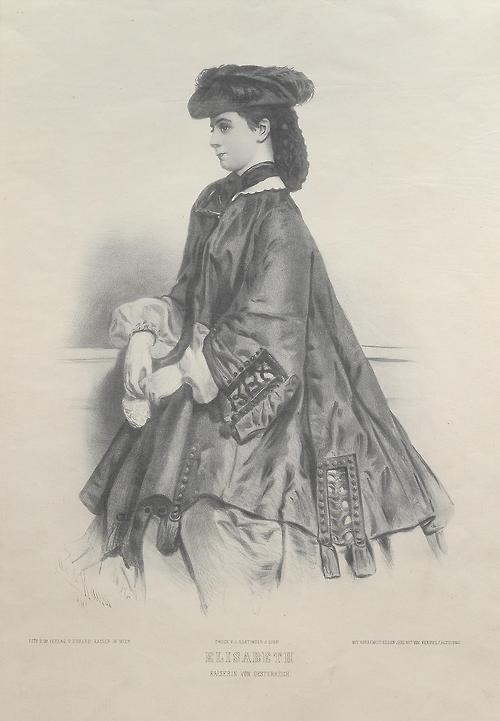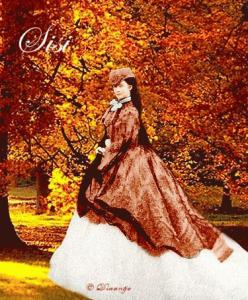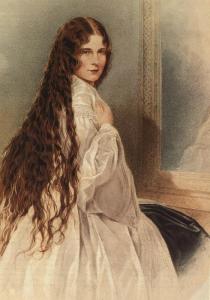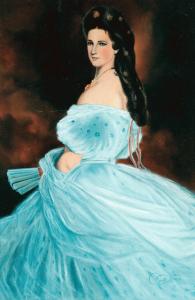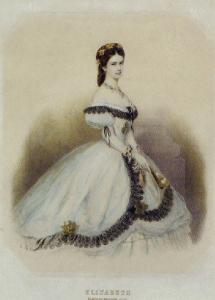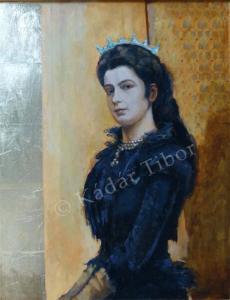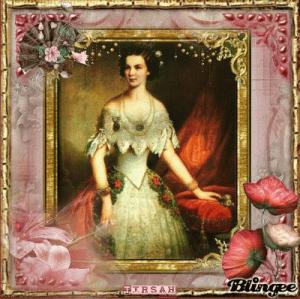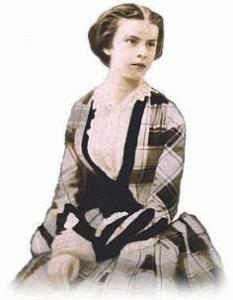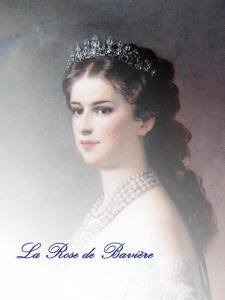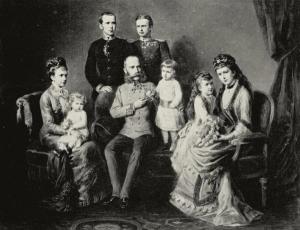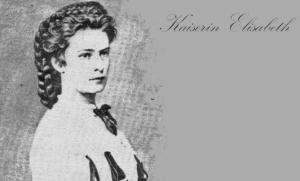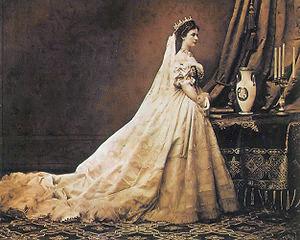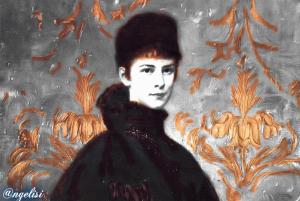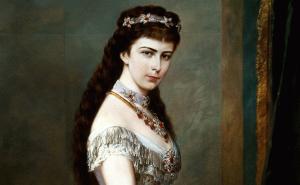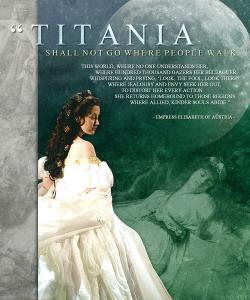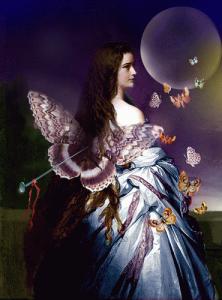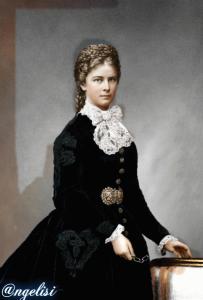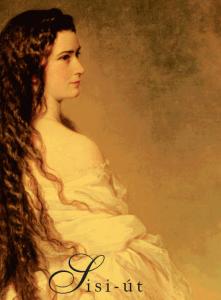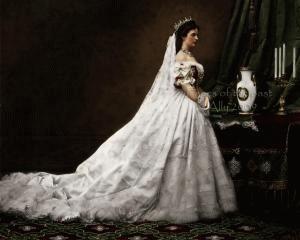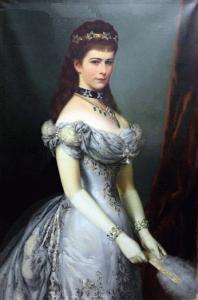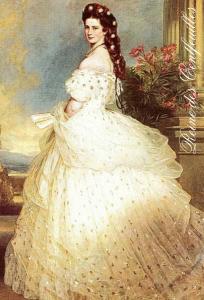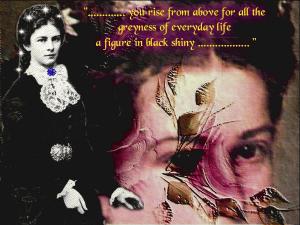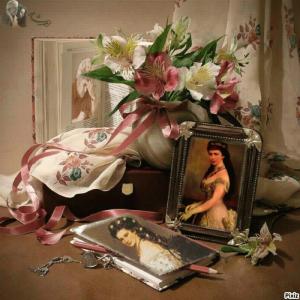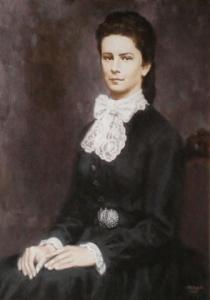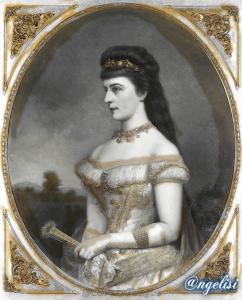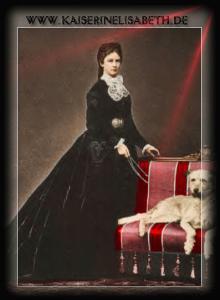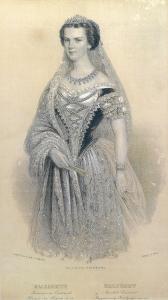Elisabeth of Bavaria a nephew of Sisi ........... on the Belgian throne
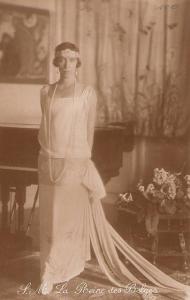
Elisabeth of Bavaria a nephew of Sisi ........... on the Belgian throne
Duchess Elisabeth in Bavaria (born Elisabeth Gabriele Valérie Marie, Duchess in Bavaria) (25 July 1876 – 23 November 1965) was Queen of the Belgians as the spouse of King Albert I. She was the mother of King Leopold III of Belgium and of Queen Marie José of Italy, and grandmother of kings Baudouin and Albert II of Belgium
Family
Born in Possenhofen Castle, her father was Karl-Theodor, Duke in Bavaria, head of a cadet branch of the Bavarian royal family, and anophthalmologist of recognized reputation. She was named in honor of her father's sister, Empress Elisabeth of Austria, better known as Sisi. Her mother was Maria Josepha of Portugal, daughter of exiled Miguel I of Portugal.
An artist himself, Duke Karl-Theodor cultivated the artistic tastes of his family and Elisabeth was raised with a deep love for painting, music and sculpture. At her father's clinic, where her mother assisted her father as a nurse, Elisabeth obtained exposure to productive labour and to human suffering unusual at that time for a princess.
Married life
In Munich on 2 October 1900, Duchess Elisabeth married Prince Albert, second-in-line to the throne of Belgium (after his father Prince Philippe, Count of Flanders). Upon her husband's accession to the Belgian throne in 1909, Elisabeth became queen. The city of Élisabethville, today Lubumbashi, in the Congo was named in her honour.
At the time that Albert and Elisabeth met, Prince Albert was the heir to his uncle Leopold II of the Belgians. Albert was the second son of Prince Philippe, Count of Flanders and Princess Marie of Hohenzollern-Sigmaringen, a sister of King Carol I of Romania.At birth, Albert occupied the third place in the line of succession behind his father and elder brother,Prince Baudouin. The unexpected death of Baudouin in January 1891 immediately raised Albert to prominence within his country. A studious, quiet man, Albert was not the choice of heir that King Leopold II would have relished. As the only living male member of his generation, Albert was guaranteed the Crown of the Belgians upon the King's death. Albert had two sisters who survived into adulthood, Princess Henriette who married Prince Emmanuel of Orléans, and Princess Josephine who married her cousin, Prince Karl-Anton of Hohenzollern-Sigmaringen, brother of King Ferdinand I of Romania.
During the First World War, she and the King resided in De Panne. The Queen made herself beloved by visiting the front lines and by sponsoring a nursing unit. Despite her German background, she was a popular queen, perceived as eagerly supporting her adoptive country.
From September 23 till November 13, 1919, the Queen, together with the King and Prince Léopold, undertook an official visit to the United States of America. During a journey in the historic pueblo of Isleta in New Mexico, the King awarded the Order of Léopold to Father Anton Docher.[1] As a memento, the King was given a turquoise cross mounted in silver made by the Tiwa people.[2] Ten thousand people traveled to Isleta for the occasion.
Later years
In 1934, Albert I died in a climbing accident in the Ardennes of Belgium, near Namur. Elisabeth lived to see her son become king (but also go into exile and abdicate), her younger son become, effectively, regent of the realm, and her grandson mount the throne.
As queen dowager, she became a patron of the arts and was known for her friendship with such notable scientists as Albert Einstein. During the German occupation of Belgium from 1940 to 1944, she used her influence as queen and German connections to assist in the rescue of hundreds of Jewish children from deportation by the Nazis. When Brussels was liberated, she allowed her palace to be used for headquarters of the British XXX Corps, and presented its commander General Horrocks with its mascot, a young wild boar named 'Chewing Gum'.[3] After the war she was awarded the title Righteous Among the Nations by the Israeli government.
During the 1950s, the Queen evoked controversy abroad by visiting the Soviet Union, China and Poland, trips that prompted some to label her as the "Red Queen."
Queen Elisabeth died in Brussels at the age of 89 on 23 November 1965. She is interred in the royal vault at the Church of Our Lady of Laeken, Brussels. She was the 1,016th Dame of the Royal Order of Queen Maria Luisa.
Children
Léopold Philippe Charles Albert Meinrad Hubertus Marie Miguel, Duke of Brabant, Prince of Belgium, who became later the fourth king of the Belgians (as Leopold III), born 3 November 1901, and died at Woluwe-Saint-Lambert on 25 September 1983.
Charles-Théodore Henri Antoine Meinrad, Count of Flanders, Prince of Belgium, Regent of Belgium, born Brussels 10 October 1903, and died at Ostend on 1 June 1983.
Marie-José Charlotte Sophie Amélie Henriette Gabrielle, Princess of Belgium, born Ostend 4 August 1906. She was married at Rome,Italy, on 8 January 1930 to Prince Umberto Nicola Tommaso Giovanni Maria, Prince of Piedmont, born on 15 September 1904, and died on 18 March 1983, at Geneva, Switzerland. He became King Umberto II of Italy on 9 May 1946. Marie-José died 27 January 2001.
Titles and styles
25 July 1876 – 2 October 1900: Her Royal Highness Duchess Elisabeth in Bavaria
2 October 1900 – 17 December 1909: Her Royal Highness Princess Elisabeth of Belgium
17 December 1909 – 17 February 1934: Her Majesty The Queen of the Belgians
17 February 1934 – 23 November 1965: Her Majesty Queen Elisabeth of Belgium
From site : http://en.wikipedia.org/wiki/Elisabeth_of_Bavaria,_Queen_of_Belgium
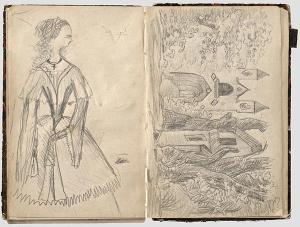
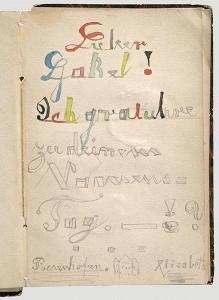
A drawing book of the later Empress of Austria.
On the flyleaf handwritten in pencil (transl.) “child’s drawing book of the later Empress Elisabeth of Austria, Duchess in Bavaria. From the estate of the Countess Camilla von Otting, her governess and courtlady”. 40 pages, predominantly pencil drawings, but also watercolours, among them the coloured draft of a congratulation for the name day of her favourite brother Carl Theordor nicknamed “Gackel”, signed “Possenhofen - Elisabeth”. The drawings depict primarily the family castle Possenhofen at Lake Starnberg and its surroundings. There are several landscape and tree sketches as well, partially with place names such as Jakobsbrunnen, Possenhofen, Garatshausen, Oberzismerung and others. The book also includes self portraits, studies of the head, of figures, fashion, animals, etc. An entire page dated “26. October” (probably around 1844) is dedicated to the portrayal of the travel preparations for the winter sojourn in Munich.
http://www.liveauctioneers.com/item/4190126
Duke Charles Theodore of Bavaria....a favourite brother of Sisi
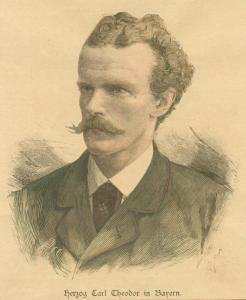 Sisi.....and her favourite brothers: Duke Charles Theodore of Bavaria.
(Possenhofen,. August 9, 1839 - Kreuth, November 30, 1909)
was a member of the House of Wittelsbach and a famous ophthalmologist. He was the brother of the Empress Elizabeth of Austria and Queen Maria Sophia of the Two Sicilies.
Life:
Charles Theodore was born at Castle Possenhofen third-born male of Duke Maximilian in Bavaria and his wife Princess Ludovica of Bavaria. Like his brothers, grew up in a state of considerable freedom, compared to the strict upbringing usually imposed on the younger members of noble families. In 1857 he began his military career, as a tradition for a member of the House of Wittelsbach. He stayed in the dorms as a common soldier. Came of age he was awarded the Order of St. Hubert and the Order of the Golden Fleece. Since his brother Luigi, to marry, in morganatic marriage, the bourgeois Henriette Mendel, had given up the birthright, those rights were transferred to Charles Theodore, who received substantial financial benefits. A master of cavalry was squadron commander of 1 º in 1 Regiment Cuirassiers. The first marriageThe February 11, 1865 in Dresden married his first cousin, Princess Sophie of Saxony, daughter of King John of Saxony and Queen Amalia Augusta, daughter of King Maximilian I of Bavaria his maternal grandfather. Even after marrying Charles remained in the army. In 1866 he took part in the war. After the birth of their first daughter, Sophia had respiratory problems that undermined his health a lot. A year later he was seized with a severe flu that led to her death March 10, 1867, at age 22. The couple had one daughter, namely: Maria Amalia (1865-1912), who was married to William of Urach. Medical StudiesThe death of his wife resulted in Carl Theodor deep inner turmoil. Having watched, helpless, on the death of Sofia prompted his medical career. The family was opposed to such a decision because he was not worthy for a prince to have a job. Encouraged by his professors, he managed to graduate. The second marriageTwo years after he finished his studies with success (in 1874), she married Jose Maria of Braganza, daughter of Michael of Portugal and Adelaide of Löwenstein-Wertheim-Rosenberg, who had met while he was guest of brother Francis II of the Two Garasthausen Sicilies at his castle on Lake Starnberg. From the second marriage were born: Sofia (22 February 1875-1957); Elizabeth (25 July 1876-1965); Maria Gabriella (October 9, 1878 to 1912); Wilhelm Ludwig (1884-1968); Franz Joseph (1888-1912). The medical professionWith Dr. Anton Mayer opened in Possenhofen a doctor's office, which supervised the local population and offered free assistance to the destitute. Arrived so more and more patients. The work even more impressive it wore out so much that in 1878 he became ill with whooping cough. With his family then moved to Mentone, where the mild climate restored him completely. Here lived Alexander von Ivanov, a famous ophthalmologist of Kiev, whose studio was like a pilgrimage site for anyone with eye problems. Charles Theodore went then to join his staff. The Duke also worked in his clinic, the famous surgeon Billroth Christian, met later in Vienna. In 1888 the new clinic was opened in Tegernsee. Also opened his own clinic in Giselastrabe but also lent his work in Monaco and elsewhere to call him. The reputation of the doctor reached Algeria, where he was called to work with the help of his daughter Sofia. DeathAfter celebrating with his family seventy, he went to Bad Kreuth to take part in a hunt. Here he fell ill with nephritis, and her condition worsened with bronchitis, which led him finally to death. The funeral was celebrated in private, as his will. The clinical ophthalmic Monaco still exists and bears his name.
From Wikipedia encyclopedia omline: http://it.wikipedia.org/wiki/ Carlo_Teodoro_in_Baviera
Sisi.....and her favourite brothers: Duke Charles Theodore of Bavaria.
(Possenhofen,. August 9, 1839 - Kreuth, November 30, 1909)
was a member of the House of Wittelsbach and a famous ophthalmologist. He was the brother of the Empress Elizabeth of Austria and Queen Maria Sophia of the Two Sicilies.
Life:
Charles Theodore was born at Castle Possenhofen third-born male of Duke Maximilian in Bavaria and his wife Princess Ludovica of Bavaria. Like his brothers, grew up in a state of considerable freedom, compared to the strict upbringing usually imposed on the younger members of noble families. In 1857 he began his military career, as a tradition for a member of the House of Wittelsbach. He stayed in the dorms as a common soldier. Came of age he was awarded the Order of St. Hubert and the Order of the Golden Fleece. Since his brother Luigi, to marry, in morganatic marriage, the bourgeois Henriette Mendel, had given up the birthright, those rights were transferred to Charles Theodore, who received substantial financial benefits. A master of cavalry was squadron commander of 1 º in 1 Regiment Cuirassiers. The first marriageThe February 11, 1865 in Dresden married his first cousin, Princess Sophie of Saxony, daughter of King John of Saxony and Queen Amalia Augusta, daughter of King Maximilian I of Bavaria his maternal grandfather. Even after marrying Charles remained in the army. In 1866 he took part in the war. After the birth of their first daughter, Sophia had respiratory problems that undermined his health a lot. A year later he was seized with a severe flu that led to her death March 10, 1867, at age 22. The couple had one daughter, namely: Maria Amalia (1865-1912), who was married to William of Urach. Medical StudiesThe death of his wife resulted in Carl Theodor deep inner turmoil. Having watched, helpless, on the death of Sofia prompted his medical career. The family was opposed to such a decision because he was not worthy for a prince to have a job. Encouraged by his professors, he managed to graduate. The second marriageTwo years after he finished his studies with success (in 1874), she married Jose Maria of Braganza, daughter of Michael of Portugal and Adelaide of Löwenstein-Wertheim-Rosenberg, who had met while he was guest of brother Francis II of the Two Garasthausen Sicilies at his castle on Lake Starnberg. From the second marriage were born: Sofia (22 February 1875-1957); Elizabeth (25 July 1876-1965); Maria Gabriella (October 9, 1878 to 1912); Wilhelm Ludwig (1884-1968); Franz Joseph (1888-1912). The medical professionWith Dr. Anton Mayer opened in Possenhofen a doctor's office, which supervised the local population and offered free assistance to the destitute. Arrived so more and more patients. The work even more impressive it wore out so much that in 1878 he became ill with whooping cough. With his family then moved to Mentone, where the mild climate restored him completely. Here lived Alexander von Ivanov, a famous ophthalmologist of Kiev, whose studio was like a pilgrimage site for anyone with eye problems. Charles Theodore went then to join his staff. The Duke also worked in his clinic, the famous surgeon Billroth Christian, met later in Vienna. In 1888 the new clinic was opened in Tegernsee. Also opened his own clinic in Giselastrabe but also lent his work in Monaco and elsewhere to call him. The reputation of the doctor reached Algeria, where he was called to work with the help of his daughter Sofia. DeathAfter celebrating with his family seventy, he went to Bad Kreuth to take part in a hunt. Here he fell ill with nephritis, and her condition worsened with bronchitis, which led him finally to death. The funeral was celebrated in private, as his will. The clinical ophthalmic Monaco still exists and bears his name.
From Wikipedia encyclopedia omline: http://it.wikipedia.org/wiki/ Carlo_Teodoro_in_Baviera
Louis William, Duke of Bavaria
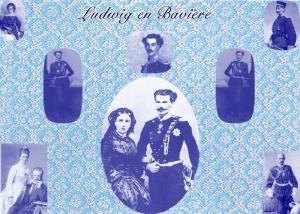
Louis William, Duke in Bavaria
(Monaco of Bavaria, June 21, 1831 - Monaco of Bavaria, November 6, 1920)
Louis is the eldest son of the Duke and Duchess Ludovica Maximilian Joseph, brother of the Empress Elizabeth. Educated at the will of his father at the public schools of Monaco, like all noble scions began his military career by entering the Fourth Cavalry Regiment König. Beautiful, enhanced by the split in the slim figure, is a very outgoing guy and lover of beautiful vita.Da always loved the theater, falls in love with Henriette Mendel, an actress of the Theatre of Augusta who saw him in Darmstadt. At first the relationship is kept secret, but the transfer of the girl in the private residence of the Duke scandal alive.
On February 24, 1858 Henriette gave birth to a child who is baptized Maria Luisa in the Church of Saint Ulrich of Augsburg, and officially recognized by Louis as a child. It is often said that everything is done in secret, but the presence of a family friend's Amalia Kolb, officially designated by the Duchess Ludovica to represent the ceremony as a sponsor of the small, escape suspicion. At this point, however, the family claim that Luigi is Mendel to take its responsibilities: the Duke formally renounce his rights of succession to the Bavarian throne (actually very far) and the right to use the title "Duke of Bavaria , "which then goes to his brother Charles Theodore. The last official act of Louis as Duke of Bavaria is to accompany his sister Maria Sophia altar representing the father during the ceremony that celebrates the marriage by proxy Francis de Bourbon, heir to the throne of the Two Sicilies. Become an ordinary citizen, no longer have access to substantial capital paternal, May 28, 1859 Louis can finally marry morganaticamente with Henriette, thanks to the interest of his sister Elizabeth, who intercedes with the King Maximilian II of Bavaria to grant a peerage to young bride.
Created Baroness Wallersee, Henrietta can now afford to attend the family and especially that of her father in-law, who always feed her unconditional sympathy. A few days after the marriage Henrietta and Luigi greet the birth of their second son, Carlo Emanuele: the child (who died a few weeks after enteritis) is soon appointed Baron Wallersee to make it clear to everyone that has no right to claim the title of duke . After the disappearance of the small, Louis, Henrietta Maria Luisa small and moving into new home to Augusta, leaving only in summer and moved into the castle Garatshausen on Lake Starnberg.
Luigi can always count on a small income made available by his brother Charles Theodore and the modest salary of a stage manager at the Theatre of Augusta. In 1866, after finally abandoned his military career, Louis moved his family to Monaco: buying land in an old brewery and built there a stately mansion unpretentious. For the daughter instead expect the best: school level, horseback riding, fencing, swimming and gymnastics.
During the summer it often happens that the Empress asks "asylum" to his brother in the castle of Garatshausen to be a bit 'in peace: it is during one of these trips, in 1869, that among the young Maria Luisa and her cousin Maria Valeria , daughter of Elizabeth, was born a friendship destined to cause scandal. Louis took the chance and let it between her sister and her daughter establish a relationship of trust: Maria Luisa knows that they are denied that opportunity would be granted to any other noble girl and believes that the friendship of the powerful sister can give me some ability. Elizabeth likes to introduce his part in the company of the "daughter of the scandal" and does everything to help her to contract a good marriage, until the violent break after the scandal at Mayerling, in which Maria Luisa has played a role very promiscuous. It is a delicate question that brings Louis and Elizabeth, always together, to move away permanently: after the suicide of Rudolf, Archduchess Marie Valerie writes in his diary, for the Empress's brother is dead.
Meanwhile, Louis retired to private life at his palace in Monaco doing the work of stage director of opera. Henrietta died on November 12, 1891.
Although shaken by the tragic death, Louis remarried a year later with Antonia Barth, dancer dell'Hoftheater: the bridegroom was sixty years old, the bride only twenty-one. New scandal. The marriage took place without anyone, including the brothers, because the break with the brothers and the daughter. Louis seems to have lost touch with reality: the young bride led him to behave like a boy, to dye his hair and mustache black and attend the festivals and the hippest clubs. To try to quell the malicious rumors, Prince Leopold, prince regent of Bavaria, the bride gives the title of "von Bartolf". The bride is a lovely little lady (at least to that of the Emperor-in-law) but light, dancer, so to speak, since its role is to "Bunny Drummer" in the folk ballets dell'Hoftheater. Pursued by the scandal he leaves Luigi Monaco and moved to Bogenhausen.
After having paid a courtesy visit in 1893, Francis Joseph wrote to his wife: "Louis has lost much hair, if it can be even thinner than before, pale old man with a mustache dyed coal black and has a certain bell 'appearance'. The death of the Empress's sister brings him back to Vienna, although relations between them were abruptly broken off after the death of Rudolph, Louis wants to attend the ceremony. "I can not prevent the poor devil to come!" Francis Joseph said to have told his daughter, Maria Valeria during the funeral of Elizabeth. The marriage of Louis and Antonia is canceled in 1913, after twenty years, with the separation as a result of the betrayal of his wife with Captain Maximilian Mayr.
The outbreak of the Great War, the consequent fall of the breakers and other former Duke lead Europe's most beautiful to live by their wits and a lot of people very respectable who take advantage of his influence on the citizens of Monaco, who never stopped that noble love of a little 'eccentric. Louis died November 6, 1920 following a heart attack. At his funeral, at his behest, are invited only his brother, Charles Theodore and his faithful secretary Düring, but also attend the grandchildren Sophia and Gisella. And 'all'Ostfriedhof buried in Monaco.
From site : http://www.elisabeth-sissi.org/biografia.php?link=5
Elena Carolina Teresa, Duchess in Bavaria
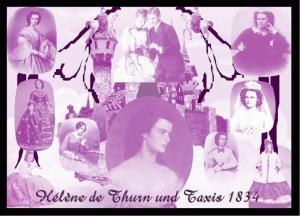 Elena Carolina Teresa, Duchess in Bavaria
(Monaco of Bavaria, April 4, 1834 - Regensburg, January 16, 1890)
Second daughter of Duke Maximilian and Princess Ludovica, Helen, said Nene, was born in Monaco of Bavaria April 4, 1834. His childhood, like that of brothers and sisters, is divided between the winters passed in the austere father's palace in Monaco and the happy summer in Possenhofen, the castle on Lake Starnberg in which the ducal family like spending the warmest part of 'year. The mother feeds her Ludovica for major projects and is not excluded that in 1848, when the door with him to Innsbruck to visit the imperial family on the run from Vienna, already was in agreement with her sister Sofia for a possible engagement on her son Francis Joseph, the future Emperor of Austria. The project was realized years later when Francis Joseph, now emperor, began to toy with the idea to marry a Catholic princess.
The Archduchess Sophia and Princess Ludovica then hatched a clear plan organizing the summer of 1853, "casually" in Bad Ischl at the birthday party of the young king. As fate would, however, that the emperor invaghisse solar freshness and naive younger sister Elizabeth, the mother arrived as escort. Elena was in fact equipped with a beauty more mature, more features hard, and especially of a more formal, having been specially educated by his mother with the prospect of becoming the wife of a prince does not matter if an emperor. Of its proud and proud that his family had been tested when, just fourteen, in 1848, Elena calmed the crowd of rioting students who had gathered under the windows of the threatening father's palace in Monaco to flush King Ludwig I and his mistress Lola Montez who took refuge there.
Singled out as "the deviation of the Emperor", deeply humiliated by the conduct of Francis Joseph, who in Bad Ischl did not use any caution in announcing that his choice had fallen on Elizabeth and not her as everyone hoped, Helen retired to private life by cultivating a faith and a devotion quite unusual in a rebellious scion of the ducal branch of the Wittelsbach. Devout, studious, serious, at twenty-two Helen was likely to be singled out as a woman condemned to remain a spinster. The mother Ludovica, conscious of the fact that no other sovereign had accepted as his wife "the refusal of the Kaiser" and looked with interest towards a truly Bachelor: Prince Maximilian of Thurn und Taxis, a scion of the noble families of the richest throughout Germany. An invitation to hunt Possenhofen offered the excuse to introduce the two boys, after they met, they promised eternal love.
But if by the Thurn und Taxis intermarry with the prospect of the king of Bavaria and the Emperor of Austria with a single shot could only be attractive, the same could not be said of the Bavarian court, where the prospect of ill-digested see real height degraded to simple princess. The King of Bavaria, Maximilian II, refusing to put his marriage and also the Archduchess Sophia made public its dissent.
However, Elizabeth, who certainly felt guilty toward her sister "displaced", she worked through her husband that of imperial pressure was granted the consent for the marriage. The round ended with a heraldic arzigogolo: Elena would be "dropped" to the rank of Princess of Thurn und Taxis, while retaining the right to the title of Royal Highness that belonged by birth. On August 24, 1854 Elena and Massimiliano convolarono wedding chapel in the bride's father had specially built in Possenhofen. The only missing component was the imperial invited sister of the bride, held in Vienna from the aftermath of the third birth. The honeymoon was held in Bad Ischl, where the two sisters were able to finally meet and spend a few days in complete serenity. Arriving in the capital of the principality of the Thurn und Taxis, Regensburg, Elena quickly became well liked by the people doing the task assigned to it very well, dealing with charities, taking a circle and doing honor to all the other typical activities of a princess.
On June 1, 1859 came on the first daughter, Louisa Matilda, followed in 1860 by Mary Elizabeth. The last pregnancy not banned from traveling to Corfu, at the request of the Emperor of Austria, to attend her sister Elizabeth in one of the many convalescence. It is rumored that the husband had left her to go Massimiliano especially away from a young officer with whom Nene would have woven a love relationship.
In 1862, Helen gave birth to the long-awaited male heir, Maximilian Maria Lamoral, followed in 1867 by his brother Albert. But the happiness of Elena, the only one of Wittelsbach sisters to live a peaceful marriage was short-lived: during that same 1867 was suddenly widowed.
With four young children, saw it fall on the shoulders full responsibility for their education and administration of the principality. That was the occasion when Elizabeth ran to his sister to stay with her, and repay the company tenutale in Corfu. As guardian of the child princess, Elena found herself managing a large inheritance which he cleverly bring in buying estates and castles: Bismarck plus more than a little depleted the coffers of the family of Thurn und Taxis depriving fruitful, the ancient administrative control of the German post.
In 1881, the untimely death of his daughter Elizabeth, married to the Duke Miguel of Braganza, Helen throws into turmoil by forcing it to seek refuge deeper in faith and prayer. The destruction of the correspondence of Helen with her confessor, Father Loeffer ago about the gossips and leaves biographers doubt that Helena already showing clear signs of mental illness that lead to death. Meanwhile he began a long pilgrimage to Rome, Paris and the Cote d'Azur, often accompanying her sister Empress. With the increased age of the mother of his son Maximilian commitments decreased drastically allowing her to live more quietly in private. But not for long: in 1885, Maximilian died suddenly died of a heart attack.
When also the second son Albert reached the age to govern, Elena, prostrated in body and mind, yet he retired to private life at the castle Garathausen on Lake Starnberg, bought by his sister Maria Sofia. Caught by a constant delirium, he returned to Regensburg in 1890, just in time to die in his capital, surrounded by the affection of his subjects and his beloved sister Elizabeth at his side.
From site : http://www.elisabeth-sissi.org/biografia.php?link=8
Elena Carolina Teresa, Duchess in Bavaria
(Monaco of Bavaria, April 4, 1834 - Regensburg, January 16, 1890)
Second daughter of Duke Maximilian and Princess Ludovica, Helen, said Nene, was born in Monaco of Bavaria April 4, 1834. His childhood, like that of brothers and sisters, is divided between the winters passed in the austere father's palace in Monaco and the happy summer in Possenhofen, the castle on Lake Starnberg in which the ducal family like spending the warmest part of 'year. The mother feeds her Ludovica for major projects and is not excluded that in 1848, when the door with him to Innsbruck to visit the imperial family on the run from Vienna, already was in agreement with her sister Sofia for a possible engagement on her son Francis Joseph, the future Emperor of Austria. The project was realized years later when Francis Joseph, now emperor, began to toy with the idea to marry a Catholic princess.
The Archduchess Sophia and Princess Ludovica then hatched a clear plan organizing the summer of 1853, "casually" in Bad Ischl at the birthday party of the young king. As fate would, however, that the emperor invaghisse solar freshness and naive younger sister Elizabeth, the mother arrived as escort. Elena was in fact equipped with a beauty more mature, more features hard, and especially of a more formal, having been specially educated by his mother with the prospect of becoming the wife of a prince does not matter if an emperor. Of its proud and proud that his family had been tested when, just fourteen, in 1848, Elena calmed the crowd of rioting students who had gathered under the windows of the threatening father's palace in Monaco to flush King Ludwig I and his mistress Lola Montez who took refuge there.
Singled out as "the deviation of the Emperor", deeply humiliated by the conduct of Francis Joseph, who in Bad Ischl did not use any caution in announcing that his choice had fallen on Elizabeth and not her as everyone hoped, Helen retired to private life by cultivating a faith and a devotion quite unusual in a rebellious scion of the ducal branch of the Wittelsbach. Devout, studious, serious, at twenty-two Helen was likely to be singled out as a woman condemned to remain a spinster. The mother Ludovica, conscious of the fact that no other sovereign had accepted as his wife "the refusal of the Kaiser" and looked with interest towards a truly Bachelor: Prince Maximilian of Thurn und Taxis, a scion of the noble families of the richest throughout Germany. An invitation to hunt Possenhofen offered the excuse to introduce the two boys, after they met, they promised eternal love.
But if by the Thurn und Taxis intermarry with the prospect of the king of Bavaria and the Emperor of Austria with a single shot could only be attractive, the same could not be said of the Bavarian court, where the prospect of ill-digested see real height degraded to simple princess. The King of Bavaria, Maximilian II, refusing to put his marriage and also the Archduchess Sophia made public its dissent.
However, Elizabeth, who certainly felt guilty toward her sister "displaced", she worked through her husband that of imperial pressure was granted the consent for the marriage. The round ended with a heraldic arzigogolo: Elena would be "dropped" to the rank of Princess of Thurn und Taxis, while retaining the right to the title of Royal Highness that belonged by birth. On August 24, 1854 Elena and Massimiliano convolarono wedding chapel in the bride's father had specially built in Possenhofen. The only missing component was the imperial invited sister of the bride, held in Vienna from the aftermath of the third birth. The honeymoon was held in Bad Ischl, where the two sisters were able to finally meet and spend a few days in complete serenity. Arriving in the capital of the principality of the Thurn und Taxis, Regensburg, Elena quickly became well liked by the people doing the task assigned to it very well, dealing with charities, taking a circle and doing honor to all the other typical activities of a princess.
On June 1, 1859 came on the first daughter, Louisa Matilda, followed in 1860 by Mary Elizabeth. The last pregnancy not banned from traveling to Corfu, at the request of the Emperor of Austria, to attend her sister Elizabeth in one of the many convalescence. It is rumored that the husband had left her to go Massimiliano especially away from a young officer with whom Nene would have woven a love relationship.
In 1862, Helen gave birth to the long-awaited male heir, Maximilian Maria Lamoral, followed in 1867 by his brother Albert. But the happiness of Elena, the only one of Wittelsbach sisters to live a peaceful marriage was short-lived: during that same 1867 was suddenly widowed.
With four young children, saw it fall on the shoulders full responsibility for their education and administration of the principality. That was the occasion when Elizabeth ran to his sister to stay with her, and repay the company tenutale in Corfu. As guardian of the child princess, Elena found herself managing a large inheritance which he cleverly bring in buying estates and castles: Bismarck plus more than a little depleted the coffers of the family of Thurn und Taxis depriving fruitful, the ancient administrative control of the German post.
In 1881, the untimely death of his daughter Elizabeth, married to the Duke Miguel of Braganza, Helen throws into turmoil by forcing it to seek refuge deeper in faith and prayer. The destruction of the correspondence of Helen with her confessor, Father Loeffer ago about the gossips and leaves biographers doubt that Helena already showing clear signs of mental illness that lead to death. Meanwhile he began a long pilgrimage to Rome, Paris and the Cote d'Azur, often accompanying her sister Empress. With the increased age of the mother of his son Maximilian commitments decreased drastically allowing her to live more quietly in private. But not for long: in 1885, Maximilian died suddenly died of a heart attack.
When also the second son Albert reached the age to govern, Elena, prostrated in body and mind, yet he retired to private life at the castle Garathausen on Lake Starnberg, bought by his sister Maria Sofia. Caught by a constant delirium, he returned to Regensburg in 1890, just in time to die in his capital, surrounded by the affection of his subjects and his beloved sister Elizabeth at his side.
From site : http://www.elisabeth-sissi.org/biografia.php?link=8
Sophia Maria Amalia
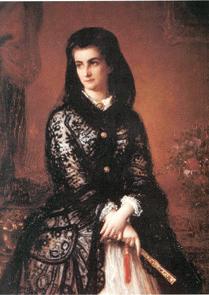
Sophia Maria Amalia
(Possenhofen October 4, 1841 - January 19, 1925 Monaco of Bavaria)
Third daughter of Duke Maximilian Joseph and Princess Ludovica, younger sister of Empress Elizabeth, Maria Sophia lived a happy childhood in the company of brothers and sisters between the castle and the palace of Possenhofen father in Monaco of Bavaria, receiving an education athletic very accurate: swimming, fencing and rifle shooting. As beautiful as Elizabeth, Mary Sophia, however, was more practical and reflective, without much sympathy for poets and intellectuals, fresh, cheerful, simple, and with that hint of rebellion that marked all his family.
After the marriage of his sister to the Emperor Francis Joseph, Maria Sofia was betrothed to Francis de Bourbon, Duke of Calabria, heir to the throne of the Two Sicilies, who married by proxy on January 8, 1859 was the last princess, the story 'Europe, married by proxy.
Francis was 23 years old and grew up in the worship of his mother, Queen Maria Cristina, who died in odor of sanctity after having given birth. With a face pale and sad and horse, the young prince looked at any of the mother and had grown chaste and solitary, but when in Bari saw for the first time Maria Sofia was fascinated and intimidated. For Maria Sofia rather than marry a seminarian from the air was a real disappointment that, apparently, became even more acute in the bedroom. It is said that the wedding night Francesco, terrified, gathered in prayer until Maria Sofia is not asleep. In fact Francis was suffering from phimosis for bigotry or cowardice had not yet done so to make work
In May 1859, Francis and Maria Sophia became the new rulers and soon found themselves between a rock and a hard liberal reactionary environment that fostered an alliance with Victor Emmanuel. The brief period during which Queen Maria Sofia was, however, was happy, because her husband did not deny anything leaving it completely clear: maybe too much! The habit of bathing in the sea guarded by all the urchins of Naples, rides in the countryside and the outputs from the palace in disguise through the streets of the capital exposed to public judgment confirming the fears of the Neapolitans who had already been put in cautions against the antics of the family's new sovereign.
In 1860, after having witnessed the collapse of the Bourbon monarchy under the pressure of Garibaldi's troops, Maria Sophia followed her husband to Gaeta, demonstrating great courage during the siege, becoming the symbol of legitimacy reactionary and redeeming his reputation. Animator of brigands Southern politician, adored by the soldiers, he continued his personal battle against the Savoy, and for this object was made by his opponents of scandalous campaigns that were aimed at tarnishing the image.
Fall of Gaeta in 1861, Mary Sophia accompanied her husband to Rome, where he lived a passionate romance with a young Belgian Count, Armand de La Lawayss Papal Guard officer responsible for ensuring its safety. So Maria Sophia found herself pregnant by her lover and, to avoid scandal, with the pretext of a disease to be cured, he returned to Possenhofen to hide the pregnancy. Elizabeth and another sister, Matilda, she was close to shorting out the tranquility of the good Duke Max, annoyed by all the chaos.
After giving birth in secret a little girl who was given to the father (though there are those who maintain that they were twins and that one of them would not be other that Mary Larisch, entrusted to his brother Louis), Mary Francis, who returned to Sofia insisted on her back side. Happy to find his wife, Francis agreed to undergo surgery and was born in 1869 their only daughter, Maria Pia Cristina, who lived only three months.
In 1870 Francesco Maria Sofia left permanently leading a wandering life in Trieste, Geneva, London and Paris, often alongside her sister Empress. In 1878 the relationship between Mary and Elizabeth Sophia cracked: the two sisters were found in England and Mary Sophia, probably jealous of the fame of Elizabeth that was inadvertently shadow, told Rodolfo some intimate details about the rumored friendship born between mother and his new companion for hunting season, Captain Bay Middleton. Rudolph, who had already been warned about the matter by some gossip going around at the court of London, reacted very violently to allegations of her aunt yelling at her mother. When Mary Elizabeth Sophia told everything to justify the scenes of Rudolph, the sisters burst into a violent quarrel that led to the word not to go for a long time.
After Francis' death in 1894 Maria Sophia lived alternately in Paris and Monaco, taking part in the plots that were aimed at a legitimist Bourbon restoration in the Two Sicilies. It seems that the ex-queen lined up even with the anarchists, through which it could work, according to some theories, his terrible revenge with the murder of Umberto I.
After the death of his sister and his brothers, his sister Sophia Matilda retired to private life in Paris, to live on a meager pension which will then be replaced by the donations of legitimist Bourbon. He died in Monaco of Bavaria in 1925 and in 1984 his remains were translated to the Basilica of Santa Chiara in Naples with her husband and daughter.
From site : http://www.elisabeth-sissi.org/biografia.php?link=7
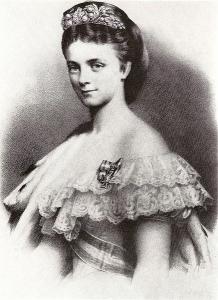
Augustina Sophie Charlotte, Duchess in Bavaria
(Possenhofen, 1847 - Paris, 1897)
Of all her sisters the fragile Sophie Charlotte Elizabeth is certainly the one for which he fought more for assicurale peace and comfort, perhaps because of the impressive physical resemblance and character development. Founded in 1847, Sophie Charlotte grew up as sisters and brothers in the peaceful, informal atmosphere of the court his father, between Monaco and Possenhofen. His life, like that of all the family, changed radically in 1853 when her older sister Elizabeth became engaged to the Emperor Francis Joseph of Austria. From that moment on, he stopped on the role of simple Bavarian duchess to become the most admired sister of the queen of Europe.
Unlike sisters Helen, Mary and Matilda, Sophia, however, was introverted, a dreamer and perpetually dissatisfied. As important as the parties in-law Louis Victor or the Duke of Wurttemberg came forward to ask for her hand got to her a flat refusal, since the girl's little head there was only room for Prince Charming. Everything seemed to change when Louis II, King of Bavaria, appealing boy, as her passion for art and music, seemed to receive preferential gallant attentions. Bound in the uniform of gala, almost two meters tall, skilled horseman, a man of culture, Louis did not take long to win the heart of the girl, but completely misunderstood these attentions: the king was looking for in fact she is not his girlfriend but her friend sincere and confidante with whom to share their passions. They spent whole days together to listen to Wagner's most beautiful arias, sung by her, while he filled her with loving care. Ran on rumors that the two were about to get engaged, even pressure on the Empress of Austria, who loved his cousin Louis and would like to see married off his sister. However, the idea of â??â??engagement deeply distressed Louis, more sensitive to the charm of the grooms male and female by lumberjacks to that, although in 1867 it surrendered to ask the girl's hand. Meanwhile the restless Sophia lived a short but intense love affair with the photographer Edgar Hanfstaengl.
Despite the official engagement, and the announcement of the wedding, the king tried every excuse to delay the marriage until the bride's father, Duke Maximilian impatiently, dared to write a letter to the king very resentful. Scandal! The pretext for Louis was more than enough: a subject of the King, Duke was also a member of the royal family could not afford to put the king in the face of an ultimatum! The engagement was publicly disbanded, the bust of girlfriend thrown out the window and the name of the king forever banished duke's palace. Meanwhile in Sofia did not stay that suffer the shame of scandal and shame, cultivating the prospect of remaining a spinster. A sad prospect that was canceled in 1868, when it was announced the engagement of the girl with the Duke of Alençon Fernando, a descendant of the French royal house of Orleans. It certainly can not say it was a marriage of love: she was too rebellious to the rigid atmosphere in the house and the gray atmosphere Orleans London certainly did not help his melancholy character, certainly predisposed to depression like that of all its sisters. Not even the birth of her daughter Louise Victoria, in 1869, seemed to lift them up again the spirit. After returning from a vacation in Sicily, in 1870, the ducal couple stopped in Rome, guests of the former King of the Two Sicilies Francis II and the former Queen Maria Sophia, sister of Sophie Charlotte. For the two sisters, both victims of a deep depression, was a joy to meet again in a city like Rome, full of parks with a temperate climate. Back in Bavaria, as republican France refused them citizenship, Sofia and Fernando began to live retired.
After the birth of her son Emmanuel, in 1872, the two managed to return to France, first at Vincennes, then in Paris. But peace was not to Sofia again expelled from France, her husband had no choice than to move in the only non-family property confiscated by the Republican government, Mentelberg Castle, near Innsbruck. Another blow to the depression of Sophie Charlotte, who found solace in the arms of a certain Hans Glaser of Graz: a relationship that threatened to throw the Bavarian royal family, the French royal and imperial house of Austria in the scandal if had not been properly concealed and the silence of those involved paid handsomely. It all ended with the internment of Sofia in a psychiatric clinic for people with depression, from which he emerged after a few months of therapy.
In 1880 he entered the Third Order of Dominicans as a lay nun with the name of Sister Mary Magdalen: he devoted himself with admirable fervor to do good works and organize exhibitions for charity. In May 1897 Sophia participated as a sponsor to a charity bazaar in Paris, on the occasion of the famous Bazar de la Charité, who had been invited, as an attraction for the public, the Lumiere brothers with their amazing new "moving pictures". The accumulated flammable equipment in the back of the tent suddenly caught fire, spreading the flames for all the stands of the fair. Sofia, let alone leave her companions, became trapped between the flames and burnt died in those tragic circumstances that took the lives of 126 people. Unfortunately, his desire to be buried in a simple gray frock could not be fulfilled, but ironically was contented himself: in his will he stipulated that his death left her long hair should be cut and burned.
There was much discussion on the relationship with this sister of Elizabeth, perhaps the most miserable of all. Certainly we know that Sissi did everything to assure a happy future and called for his public marriage with the King of Bavaria, but later could not but welcome the fact that her sister had escaped to a married life nothing short of impossible. Not pardoned but the escapade with Glaser and dedicated some verses of a poem: "You wanted to leave her husband and children with cowardice, and your captor or take away the sinful hope must vanish, where you now dwell s'ha not escape." After the funeral of Sofia, where he buried the skull only recognized by the maid through an examination of the teeth, Elizabeth went to Innsbruck to greet his brother in law widower. On that occasion it seems that the Empress has said: "We are all doomed to violent death." A year later he died assassinated by the anarchist Italian Luigi Lucheni on the shores of Lake Geneva.
from site :http://www.elisabeth-sissi.org/biografia.php?link=9
Augustina Sophie Charlotte, Duchess in Bavaria
 Matilda Ludovica, Duchess in Bavaria, Countess of Trani
(Monaco and Munich, September 30, 1843 - Monaco of Bavaria, June 18, 1925)
Fourth daughter of the Duke and Duchess Ludovica Maximilian Joseph, the younger sister of Empress Elizabeth, Matilda lives the first youth in the company of brothers and sisters between the castle and the palace of Possenhofen father in Monaco. Nicknamed "Spatz", meaning "sparrow" because of the growing cheerful, after the marriage of his sister Elizabeth to the Emperor of Austria and sister Maria Sofia with King Francis II of the Two Sicilies, Matilde is sacrificed by her mother to an arranged marriage.
Although the kingdom of the Two Sicilies was swept away by the fury of Garibaldi, the choice is right on the Bourbons of Naples, precisely, of Louis, Count of Trani, brother of former King Francis II. On 1 June 1861 Matilda is reached in Monaco from future husband, who for the occasion by the King of Bavaria received the Cross of St. Hubert, the highest honor of the kingdom. On June 5, the marriage is celebrated in the Church of All Saints: Matilda became Countess of Trani and his sister in-law, ex-Queen Maria Sofia. Already the next day, accompanied by brothers Charles and Louis Theodore, leave Bavaria for Rome, where he joined his sister Maria Sophia who lives with her husband in exile. Since the beginning, marriage is revealed for what it is: a union forced without a future. The groom, gracilino and insignificant, ambitious, full of resentment against the brother, he does not consider the wife leaving her alone to devote to the dancers and alcohol. Ritrovatesi in Rome, now no formal role, the two sisters live on the complicity of a fun time walking on the course, riding in the Villa Borghese and arousing scandal smoking in public. During this stay, thanks to the sister, Matilda lives a happy and passionate with an overwhelming, albeit brief, love affair with the beautiful Belgian General Salvador Bermudez De Castro, Marquis de Lama. On January 15, 1867, in Zurich, Matilda gave birth to his only daughter Maria Teresa (nicknamed Madi): more than one doubt arises on the paternity of the child. During the difficult question of pregnancy secret of his sister Maria Sophia, became pregnant after an affair with Arman de Lawayss, Matilda stand by her trying to handle it as discreetly as possible, attendendola in Rome, trying to make her forget the bad Experience.
The storm had passed, in 1871, in Rome, will be joining them the third sister, Sophie Charlotte, Duchess of Alençon's not a happy family reunion for the two sisters "Italian" already suffering from serious bouts of depression due to situation of their families and the arrival of Sophie Charlotte, also proven by a deep depression crisis, certainly does not help morale.
On April 22, 1868, with his sister Maria Sophia, Matilda, he moved to Budapest to attend as godmother at the baptism of his niece Maria Valeria, the daughter of his sister Elizabeth. In 1886, remains a widow is said that Louis committed suicide by jumping into the lake of Zug, Switzerland, but this is due to a misunderstanding which confuses him with his brother actually died of illness in Paris. Accompanied the coffin of her husband in Baden Baden, Matilda settled there with his daughter for a long time choosing the spa town as an official residence. Just in Baden Baden, in 1889, is celebrated the betrothal of Maria Theresa with Prince William of Hohenzollern Sigmaringen. Between 1894 and 1896 Matilde spends much time with her sister Elizabeth in Cote d'Azur: the two sisters, always a bit 'far apart, find themselves in peace and serenity in a holiday period, although Matilda is too weak to follow health Elizabeth in his long walks.
In 1897 he was in Paris when her sister Sophie Charlotte died in the fire of the bazaar of the Charité in an attempt to save some of the girls remained in the building on fire: it will be up to you to recognize the few remains of his sister. Elizabeth and Matilda will salute for the last time in 1898 in Monaco, when Sissi passes quickly from the capital to greet his sister before leaving for Switzerland, where he is killed on the shores of Lake Geneva. After the tragic death of the empress, Matilda just moved to Geneva, where he lives in a hotel for a long period, until 1909, when his daughter Maria Theresa dies after dell'aggravarsi the terrible disease that affects the spinal cord from from birth. After 1919, the war ended, the empire disintegrated, Matilda is suspended in the small privilege that allows her to live in a decent and has just been forced to return to Monaco and to go and live with her sister Maria Sofia Hotel Königshof and then Possenhofen. During the first months of 1924 Matilda suffers a bad accident, which lack the details, as a result of which was admitted in hospital and emergency surgery: the rehabilitation unit is installed on a painful leg. Completely ill, almost blind, assisted by a nurse, lives the last years of his life tormented by excruciating pain. He died June 18, 1925 after having seen all the brothers and sisters. Monaco is buried in the tomb of his lady companion Nelly von Schmidt. Since no one will pay the fee for the maintenance of the grave, it will be destroyed and dismantled. The cross, saved by a faithful family friend, is brought in Sigmaringen, where it is still exposed in the choir of Hedinger Kirche.
From site : http://www.elisabeth-sissi.org/biografia.php?link=6
Matilda Ludovica, Duchess in Bavaria, Countess of Trani
(Monaco and Munich, September 30, 1843 - Monaco of Bavaria, June 18, 1925)
Fourth daughter of the Duke and Duchess Ludovica Maximilian Joseph, the younger sister of Empress Elizabeth, Matilda lives the first youth in the company of brothers and sisters between the castle and the palace of Possenhofen father in Monaco. Nicknamed "Spatz", meaning "sparrow" because of the growing cheerful, after the marriage of his sister Elizabeth to the Emperor of Austria and sister Maria Sofia with King Francis II of the Two Sicilies, Matilde is sacrificed by her mother to an arranged marriage.
Although the kingdom of the Two Sicilies was swept away by the fury of Garibaldi, the choice is right on the Bourbons of Naples, precisely, of Louis, Count of Trani, brother of former King Francis II. On 1 June 1861 Matilda is reached in Monaco from future husband, who for the occasion by the King of Bavaria received the Cross of St. Hubert, the highest honor of the kingdom. On June 5, the marriage is celebrated in the Church of All Saints: Matilda became Countess of Trani and his sister in-law, ex-Queen Maria Sofia. Already the next day, accompanied by brothers Charles and Louis Theodore, leave Bavaria for Rome, where he joined his sister Maria Sophia who lives with her husband in exile. Since the beginning, marriage is revealed for what it is: a union forced without a future. The groom, gracilino and insignificant, ambitious, full of resentment against the brother, he does not consider the wife leaving her alone to devote to the dancers and alcohol. Ritrovatesi in Rome, now no formal role, the two sisters live on the complicity of a fun time walking on the course, riding in the Villa Borghese and arousing scandal smoking in public. During this stay, thanks to the sister, Matilda lives a happy and passionate with an overwhelming, albeit brief, love affair with the beautiful Belgian General Salvador Bermudez De Castro, Marquis de Lama. On January 15, 1867, in Zurich, Matilda gave birth to his only daughter Maria Teresa (nicknamed Madi): more than one doubt arises on the paternity of the child. During the difficult question of pregnancy secret of his sister Maria Sophia, became pregnant after an affair with Arman de Lawayss, Matilda stand by her trying to handle it as discreetly as possible, attendendola in Rome, trying to make her forget the bad Experience.
The storm had passed, in 1871, in Rome, will be joining them the third sister, Sophie Charlotte, Duchess of Alençon's not a happy family reunion for the two sisters "Italian" already suffering from serious bouts of depression due to situation of their families and the arrival of Sophie Charlotte, also proven by a deep depression crisis, certainly does not help morale.
On April 22, 1868, with his sister Maria Sophia, Matilda, he moved to Budapest to attend as godmother at the baptism of his niece Maria Valeria, the daughter of his sister Elizabeth. In 1886, remains a widow is said that Louis committed suicide by jumping into the lake of Zug, Switzerland, but this is due to a misunderstanding which confuses him with his brother actually died of illness in Paris. Accompanied the coffin of her husband in Baden Baden, Matilda settled there with his daughter for a long time choosing the spa town as an official residence. Just in Baden Baden, in 1889, is celebrated the betrothal of Maria Theresa with Prince William of Hohenzollern Sigmaringen. Between 1894 and 1896 Matilde spends much time with her sister Elizabeth in Cote d'Azur: the two sisters, always a bit 'far apart, find themselves in peace and serenity in a holiday period, although Matilda is too weak to follow health Elizabeth in his long walks.
In 1897 he was in Paris when her sister Sophie Charlotte died in the fire of the bazaar of the Charité in an attempt to save some of the girls remained in the building on fire: it will be up to you to recognize the few remains of his sister. Elizabeth and Matilda will salute for the last time in 1898 in Monaco, when Sissi passes quickly from the capital to greet his sister before leaving for Switzerland, where he is killed on the shores of Lake Geneva. After the tragic death of the empress, Matilda just moved to Geneva, where he lives in a hotel for a long period, until 1909, when his daughter Maria Theresa dies after dell'aggravarsi the terrible disease that affects the spinal cord from from birth. After 1919, the war ended, the empire disintegrated, Matilda is suspended in the small privilege that allows her to live in a decent and has just been forced to return to Monaco and to go and live with her sister Maria Sofia Hotel Königshof and then Possenhofen. During the first months of 1924 Matilda suffers a bad accident, which lack the details, as a result of which was admitted in hospital and emergency surgery: the rehabilitation unit is installed on a painful leg. Completely ill, almost blind, assisted by a nurse, lives the last years of his life tormented by excruciating pain. He died June 18, 1925 after having seen all the brothers and sisters. Monaco is buried in the tomb of his lady companion Nelly von Schmidt. Since no one will pay the fee for the maintenance of the grave, it will be destroyed and dismantled. The cross, saved by a faithful family friend, is brought in Sigmaringen, where it is still exposed in the choir of Hedinger Kirche.
From site : http://www.elisabeth-sissi.org/biografia.php?link=6




